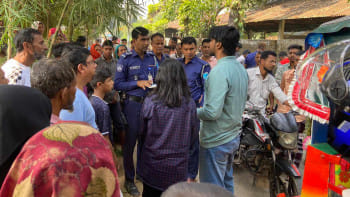Making art mainstream

Galleri Kaya is set to celebrate their 15th anniversary through an exhibition featuring a selection of art works done between 1957 and 2019 by 43 modern and contemporary artists from Bangladesh and India, from 15 to 20 July, 2019.
We met artist Goutam Chakraborty, director of the Gallery, in his studio to discuss Kaya, success and failures, and perception of art,
In the last 15 years, Galleri Kaya has successfully bridged the aesthetics of art with its commercial aspects. For a country without a properly established art market, this alone is significant.
The Galleri is known among art lovers for their regular and varied exhibitions-- watercolours, prints, and masks, among others. Group exhibitions and solos are also recurring events in their annual scheme.
Goutam Chakraborty talked of plans for 2019. He said some projects do roll over to subsequent years, but they stand on a solid foundation in terms of planning.
"Think Big, Start Small," a framed piece hangs on a wall of the Kaya office.
Their art camps around the country, and at times in foreign locations, give newcomers a chance to brush shoulders with some of the giants of the field. Perhaps that is a secondary objective.
The success of such camps is in the exhibitions that follow, and the work of the artists in their added dimensions.
One of their more successful events was the group exhibition featuring artworks done in natural dyes — "green" in the environmental sense.
The unfamiliar media created some unique pieces that will remain as some of the most important works in the post 2000 arts scene. The chemistry that happened in the literal sense, and equally a figurative one, is that the techniques being the same, the results varied.

Themes are also a recurring affair. Galleri Kaya's exhibitions on "Charcoal" and "Prints" have been soothing pleasures to patrons.
A print is for people with taste rather than money — a dictum the gallery seems to share with the great master, M H Husain. Galleri Kaya has made significant contribution in popularising prints as a legit art form in a market where people disdainfully look at them as 'duplicates.'
A smooth flow of ideas and a cultural harmony is also one feat the Galleri makes as deliberate attempt to achieve. The exhibition that opens on 5 July, 2019 shall feature works of Indian masters like Subramanian, Husain, and Raza, along with many other signature names of modern Indian art.
For those who prefer a walk through galleries over art reviews, this is a rare opportunity to observe the works of our great masters — Safiuddin, Debdas Chakraborty, Aminul Islam, Dipa Haq, and living legends like Baseer, Nabi, and others. In a world where geographical boundaries divide us, such endeavours help create a mind that think without borders.
Chakraborty presents these as his humble contribution to art and its market.
Over the last few decades, art by Bangladeshi painters has soared, yet the market is bound within the demography of the capital. Almost five decades have passed since independence, but we still do not have a large enough pool of connoisseurs, or patrons.
Goutam Chakraborty says that they are fortunate enough to have the ADN Group as sponsors of the exhibitions for the last four years.
Some investors do buy works by prominent artists, but the young are somewhat neglected. And without financial support, they lack the opportunity to devote time to quality over quantity. This often pushes artists to plagiarism, in the sense that they create what sells, rather than nurturing their innovative thoughts.
Chakraborty explains the disastrous effect that a small pool of art lovers can have for our future. The sense of ownership is an important factor in the entire art experience, but the reality is that artworks are now beyond the reach of most buyers. People lose interest as they fail to experience the pleasure of ownership.
Yet, one must realise that Picasso is beyond reach for the average Joe, but appreciating his charisma does not cost a penny.
Bangladesh also lacks a secondary art market. It is not clear if the million taka pieces sold at galleries are realising a similar figure once they are changing hands. Whether they are changing hands is also a matter of greater concern.

Once the steady curve of an art market reaches a plateau, the pieces that are now being bought should give a financial return. And unless that happens, the plateau will come spiralling down.
But Goutam Chakraborty is one who believes that it is possible to change the tide. Appreciation of art and its commercial aspects go hand in hand.
In the last 15 years, Galleri Kaya has done much to promote art, yet Goutam Chakraborty can pride himself in claiming that he is the rare few who has helped in the understanding of the commerce of the trade, without showing any neglect or disdain for new comers and great masters.
Galleri Kaya is located at House #20, Road #16, Sector 4, Uttara. #01752684900, 58956902
Photo courtesy: Galleri Kaya


 For all latest news, follow The Daily Star's Google News channel.
For all latest news, follow The Daily Star's Google News channel. 



Comments